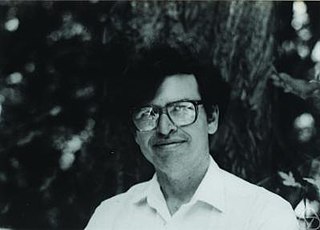In mathematics, the group algebra is any of various constructions to assign to a locally compact group an operator algebra, such that representations of the algebra are related to representations of the group.
In mathematics, the spectrum of a C*-algebra or dual of a C*-algebraA, denoted Â, is the set of unitary equivalence classes of irreducible *-representations of A. A *-representation π of A on a Hilbert space H is irreducible if, and only if, there is no closed subspace K different from H and {0} which is invariant under all operators π(x) with x ∈ A. We implicitly assume that irreducible representation means non-null irreducible representation, thus excluding trivial representations on one-dimensional spaces. As explained below, the spectrum  is also naturally a topological space; this is similar to the notion of the spectrum of a ring.

Geometric group theory is an area in mathematics devoted to the study of finitely generated groups via exploring the connections between algebraic properties of such groups and topological and geometric properties of spaces on which these groups act.

In mathematics, a 3-manifold is a space that locally looks like Euclidean 3-dimensional space. A 3-manifold can be thought of as a possible shape of the universe. Just as a sphere looks like a plane to a small enough observer, all 3-manifolds look like our universe does to a small enough observer. This is made more precise in the definition below.
In mathematics, more precisely in topology and differential geometry, a hyperbolic 3–manifold is a manifold of dimension 3 equipped with a hyperbolic metric, that is a Riemannian metric which has all its sectional curvatures equal to -1. It is generally required that this metric be also complete: in this case the manifold can be realised as a quotient of the 3-dimensional hyperbolic space by a discrete group of isometries.
William Mark Goldman is a professor of mathematics at the University of Maryland, College Park. He received a B.A. in mathematics from Princeton University in 1977, and a Ph.D. in mathematics from the University of California, Berkeley in 1980.
In mathematics, a Fuchsian model is a representation of a hyperbolic Riemann surface R as a quotient of the upper half-plane H by a Fuchsian group. Every hyperbolic Riemann surface admits such a representation. The concept is named after Lazarus Fuchs.
In mathematics, the Teichmüller spaceT(S) of a (real) topological surface S, is a space that parametrizes complex structures on S up to the action of homeomorphisms that are isotopic to the identity homeomorphism. Each point in T(S) may be regarded as an isomorphism class of 'marked' Riemann surfaces where a 'marking' is an isotopy class of homeomorphisms from S to itself.
In mathematics, Mostow's rigidity theorem, or strong rigidity theorem, or Mostow–Prasad rigidity theorem, essentially states that the geometry of a complete, finite-volume hyperbolic manifold of dimension greater than two is determined by the fundamental group and hence unique. The theorem was proven for closed manifolds by Mostow (1968) and extended to finite volume manifolds by Marden (1974) in 3 dimensions, and by Prasad (1973) in all dimensions at least 3. Gromov (1981) gave an alternate proof using the Gromov norm.
In mathematics, the geometric topology is a topology one can put on the set H of hyperbolic 3-manifolds of finite volume.
Brian Hayward Bowditch is a British mathematician known for his contributions to geometry and topology, particularly in the areas of geometric group theory and low-dimensional topology. He is also known for solving the angel problem. Bowditch holds a chaired Professor appointment in Mathematics at the University of Warwick.
In mathematics, more precisely in group theory and hyperbolic geometry, Arithmetic Kleinian groups are a special class of Kleinian groups constructed using orders in quaternion algebras. They are particular instances of arithmetic groups. An arithmetic hyperbolic three-manifold is the quotient of hyperbolic space by an arithmetic Kleinian group. These manifolds include some particularly beautiful or remarkable examples.
James W. Cannon is an American mathematician working in the areas of low-dimensional topology and geometric group theory. He was an Orson Pratt Professor of Mathematics at Brigham Young University.
In hyperbolic geometry, the ending lamination theorem, originally conjectured by William Thurston (1982), states that hyperbolic 3-manifolds with finitely generated fundamental groups are determined by their topology together with certain "end invariants", which are geodesic laminations on some surfaces in the boundary of the manifold.
The geometry and topology of three-manifolds is a set of widely circulated but unpublished notes by William Thurston from 1978 to 1980 describing his work on 3-manifolds. The notes introduced several new ideas into geometric topology, including orbifolds, pleated manifolds, and train tracks.
This is a glossary of terms that are or have been considered areas of study in mathematics.
Albert Marden is an American mathematician, specializing in complex analysis and hyperbolic geometry.






